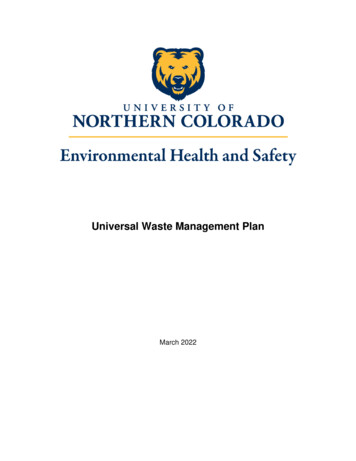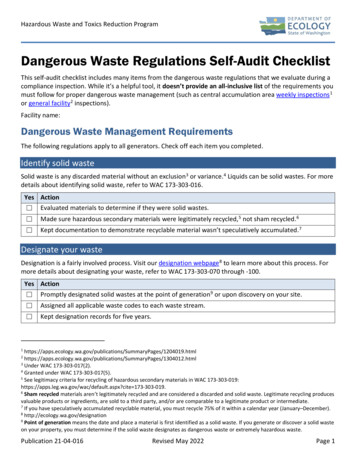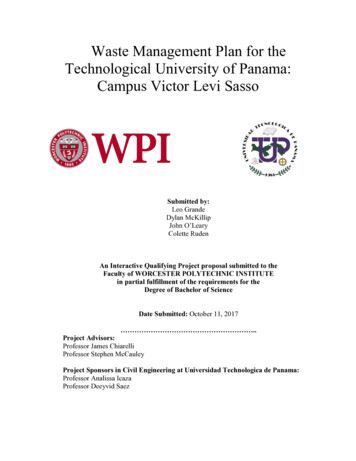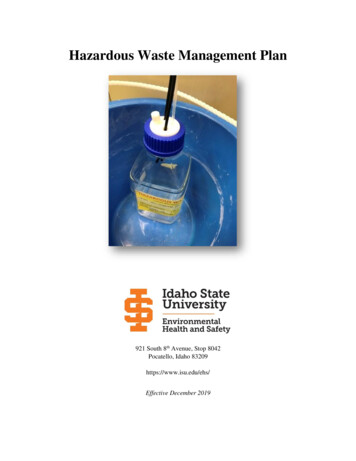
Transcription
Universal Waste Management PlanMarch 2022
Universal Waste Management PlanI.IntroductionII.Regulatory AuthorityIII.Universal Waste Handler StatusIV.Universal Waste Accumulation AreaV.Universal Waste TypesVI.Accumulation Time LimitsVII.Proper Labeling of ContainersVIII.InspectionsIX.Hazardous Materials ReleaseX.Offsite Shipment/TransportationXI.Record KeepingXII.TrainingXIII.Emergency ProceduresAppendicesAppendix A - Hazardous Material / Waste TagAppendix B - Universal Waste Label InformationAppendix C - Picture Guide - Parsons Hall Universal Waste Storage AreaAppendix D – Universal Waste Batteries Reference GuideAppendix E - Low-level Mercury Bulb Picture Reference GuideAppendix F- Universal Waste Area Monthly Inspection Sheet
Universal Waste Management PlanI. IntroductionThe University of Northern Colorado collects and disposes of Universal Waste inaccordance with the United States Environmental Protection Agency (EPA) and theColorado Department of Public Health and Environment (CDPHE) regulations.Universal Wastes are a sub-category of Hazardous Wastes, but the Universal Wasterule provides for reduced management and record keeping requirements for thosespecific wastes. While the majority of hazardous waste is generated by industry andlaboratories, universal wastes are generated by nearly every business as well as privateresidents. Although the regulation of Universal Wastes is simplified and streamlined,Universal Waste materials cannot be placed in regular trash, tossed on the ground, orpoured down the drain.The Universal Waste Management Plan provides one process for written documentationof Universal Waste records for the University of Northern Colorado (UNC). It will alsoinform interested persons, including university and contracting employees, of UNC’scompliance with the EPA requirements for Universal Waste generators.II. Regulatory AuthorityUniversal waste is regulated by the EPA under 40 CFR 273 (Standards for UniversalWaste Management) and the CDPHE Universal Waste Rule [Colorado HazardousWaste Regulations 6 CCR 1007-3 Part 273].Campus PolicyUNC Board of Trustees has adopted a policy (1-1-507 Hazardous Materials) whichstates:Employees who handle toxic or hazardous substances on behalf of the University arerequired to maintain, use and dispose of such substances in accordance with applicableUNC Hazardous Material Management Plan procedures, state, federal and locallaws/regulations as a condition of their employment. The employee should obtainassistance in ascertaining his/her obligations under these laws and regulations from theDirector of Environmental Safety or his/her designee. Any employee who violates anysuch laws or instructions given by the University Environmental Health and SafetyOffice shall be deemed to have acted outside the scope of his/her authority.
III. UNC Universal Waste Handler StatusThe University of Northern Colorado is a large quantity handler of universal waste.Large quantity handlers are those that accumulate a volume of 5,000 kilograms (11,023pounds) or more of universal waste items annually. Elemental mercury shall not exceeda volume of 35 kilograms (77 pounds) at one time.IV. Universal Waste Accumulation AreaUniversal wastes must be stored in a designated waste storage area with sufficientspace to accumulate and store the quantity of Universal Wastes generated. UNC’sUniversal Waste Accumulation Area is located at Cogen Building. The accumulationand storage of universal wastes must be managed in a manner that prevents therelease of waste or waste constituents. All waste should be immediately containerizedinto the appropriate designated vessel when placed in the Universal WasteAccumulation Area. Materials that do not have a designated vessel/storage locationshould never be left in this area, contact EHS for proper disposal.V. Universal Waste TypesUniversal waste that is handled at UNC Cogen Building includes: batteries, mercurycontaining devices, lamps, pesticides, aerosol cans, and Light Emitting Diode, betterknown as LED.A. BatteriesBatteries collected at the University of Northern Colorado have a battery chemistrythat includes lead acid, Nickel Metal Hydride (NiMH), and Nickel Cadmium (NiCd).Varying shapes, sizes, and styles can include cylindrical, rectangular, flat cells,button cells, lanterns, nine volts, and battery packs. A battery becomes universalwaste when it is removed from service. Automotive lead acid batteries must behandled as universal waste and shall be disposed of through Facilities Management.For proper documentation see Section VII, Proper Labeling of Containers.Batteries that are not regulated as a Universal Waste include Alkaline, zinc carbon,zinc chloride, lithium-ion and non-automotive lead acid. These types of batteries aredisposed of through recycling. A picture guide of the various types of batteries thatare recycled as universal wastes can be found in Appendix D.B. Mercury Containing DevicesThermostats, thermometers, manometers, barometers, sphygmomanometers,relays, and switches are all examples of devices that may contain mercury. Thesedevices can be managed under the universal waste rule provided they are intact.
C. Lamps/BulbsLamps, bulbs, or tube portions of electrical lighting devices, may contain smallamounts of mercury. There may also be small amounts of cadmium in some types oflamps. Lamps considered to be universal waste can be fluorescent, metal halide, ormercury vapor. Small compact, U-tube, straight, and standard light bulb shapes areall very commonly found in universal waste.Non-mercury containing lamps that are utilized by the University campus can bedisposed of in the solid waste dumpster. Always verify that the bulb is a nonmercury or low-level mercury bulb before disposal. See Appendix E for a pictorialreference guide of the low-level mercury containing bulbs that may be found oncampus. Low-level mercury bulbs that could be used on campus may include thefollowing: General Electric Bulbso Ecoluxo Ecolux Starcoato Ecolux UltraMaxo Ecolux Biaxo Ecolux Lucaloxo Ecolux Mod-U-lineSylvania Bulbso Ecologico OCTRON Ecologico PENTRON Ecologico Lumalux (Plus) Ecologico ICETRON Ecologico Powerball CRI EcologicPhillips Bulbso ALTOo Ceramalux ALTOo Universals ALTOo U Bent ALTOo PL-C Cluster ALTOo PL-S Short ALTOo PL-T Triple ALTOo MasterColor CDM ALTOo Dim AltoIn the case of a Universal Waste spill, see Section XIII, Emergency Procedures.D. Light Emitting DiodeLight Emitting Diode (LED) is recognized and categorized as e-waste (ColoradoHazardous Waste Regulation Part 273.2) and are considered Universal Waste.
LED’s will be disposed of through Facilities Management. For proper documentationsee Section VII, Proper Labeling of Containers. Colorado Hazardous WasteRegulations Part 273 states that all LED’s will be disposed as e-waste because ofthe electronic component in the lamp. Regulations are designed to reduce theregulatory burden on facilities that generate these wastes while at the same timereducing the amount of hazardous waste illegally sent to municipal solid wastelandfills.E. PesticidesPesticides that have been recalled or banned from use, are obsolete, have becomedamaged, or are no longer needed due to changes in procedures or other factors,are considered a universal waste.F. Computers and Electronic DevicesElectronic devices considered to be universal waste include computer monitors andcircuit boards. University computers that are no longer in service should be turned into the Information Management and Technology (IMT) department. IMT will assesselectronic and computer equipment prior to disposal. Proper recycling and disposalwill be coordinated through Facilities Management.VI. Accumulation Time LimitsUniversal waste can be accumulated for up to one year from the date it became awaste. The amount of time that a universal waste has been accumulated must bedemonstrated, in any one of the following ways:1. Directly marking the universal waste with the date that it became a waste.2. Marking the container with the earliest date that waste began accumulating in thatcontainer.3. Marking a designated accumulation area with the earliest date that waste beganaccumulating in that area.4. Keep an inventory that identifies the date that each universal waste becamewaste5. Keeping an inventory that identifies the earliest date that a universal wastebecame a waste in the designated accumulation area.VII.Proper Labeling of ContainersAll Universal Waste containers must be labeled at the time the first waste is generatedin the container. If you have Universal Wastes that need to be disposed of, fill out aUNC waste tag (See Appendix A), and attach it to the container of materials beingdisposed of. These tags allow EHS to know exactly what the waste is so it can beplaced in the correct container in the central Universal Waste Storage Area in theParsons Hall Garage.
Containers in the central Universal Waste Storage Area should each have a purple,universal waste label stuck on in a visible location, the label shall display theaccumulation start date for each specific container. Appendix B shows the universalwaste label and describes how it is to be filled out.VIII.InspectionsEnvironmental Health and Safety will monitor the central Universal Waste storage areato ensure the waste is properly segregated, containers are in good condition, the area isorganized, and good housekeeping is being maintained. If a container is full ordamaged notify the EHS Department. A monthly inspection will be done for bestmanagement practices. Appendix F shows the inspection sheet.IX. Hazardous Materials ReleaseSpills or residues from universal waste may be considered hazardous materials / wasteif any or all the released material or residue is hazardous. Spills should be reported toUNC Police Department (970) 351-2245 or the Facilities Management Service Center(970) 351-2446 immediately. If the materials released in the spill are consideredhazardous, it must be managed as hazardous waste rather than universal waste.X. Offsite Shipment/TransportationUniversal waste can only be shipped to a certified universal waste handler, or aTransfer, Storage, Disposal, or Recycling Facility (TSDRF). Prior to shipping universalwaste off-site, the generator of the waste must obtain approval from the destinationfacility. The EHS department is responsible for scheduling and approving all wasteshipping documents.XI. Record KeepingAll universal waste management activities shall be documented. The following aredocumentation requirements that will be maintained by EHS. All universal waste documentation related to transportation, shipment, regulatoryreporting, etc. Hazardous Material / Waste tags Universal Waste Management release records Initial / Annual universal waste management training records All other universal waste management documentationThese records must be kept for a minimum of three years.
XII.TrainingAs a large quantity waste handler of universal waste, UNC must ensure that employeeswho manage or handle universal waste are thoroughly familiar with waste handlingmethods and emergency procedures applicable to the waste they are handling, andrelative to their responsibilities during normal University operations and emergencies.All training records must include the dates of training sessions, contents or a summaryof the training session, name of the trainer, and names of the individuals attending thetraining session. Training that is conducted by departments should send a copy of thetraining roster to EHS.XIII.Emergency ProceduresThe University is committed to the management of Universal Waste to minimize thepossibility of an accidental release into the environment. As part of this commitment,UNC maintains equipment on-site to facilitate spill cleanup.The University has a Spill Prevention, Control, and Countermeasure (SPCC) Plan andHazardous Materials Incidents Emergency Response Plan that is maintained by theEHS department. These plans support spill response and emergency situations relatedto the Universal Waste Management Program. In case of a spill or release immediatelycontact UNC Police Department at 351-2245 immediately. The Hazardous MaterialsIncident Emergency Response Plan shall be used as a guide during any release, spill,or incident.
Appendix AHazardous Material / Waste Tag** – Information that is not required for Universal WastesYour DepartmentBuilding & Room Number (ifapplicaple)Person or lab that generatedthe waste & their contactnumber **Location Where Material isBeing Stored **Material or Chemical beingDisposed ofApproximate (%) of each typeof material or component **Container size & type (i.e.1L metal, 5gal plastic) **For Universal Wastes, writeapproximate quantity of eachtype of wasteGenerator’s signature & DatePlease attach the bottom copy of the tag to the waste container.The top copy of each waste tag can be sent to the EHS Department at Campus Box 57, ordropped off at the Parsons Hall Service Center, located at 501 20th Street.
Appendix B Universal Waste Label InformationParsons Hall - Universal Waste Storage Area- Waste Label Information -“Waste Batteries” or “Waste Bulbs”Labels should indicate materials are “spent” or “waste”Date should reflect when the firstItem was placed in containerUniversity of Northern Colorado411 20th StreetGreeley, CO 80639For Any Questions Contact:Mary Nguyen, EHSParsons Hall, Room 2020Phone: 970-351-1270Email: mary.nguyen@unco.edu
Appendix CPicture Guide - Cogen Universal Waste Storage Area
Appendix DLow-level Mercury Bulb Picture Reference Guide
Appendix ELow-level Mercury Bulb Picture Reference GuideGeneral Electric BulbsEcoluxEcolux StarcoatEcolux LucaloxEcolux UltramaxEcolux BiaxEcolux Mod-U-lineSylvania BulbsEcologic/OCTRON EcologicPENTRON Ecologic Lumalux (Plus) Ecologic
ICETRON ecologicPowerball CRI EcologicPhillips BulbsALTOPL-C ALTOCeramalux ALTOPL-S ALTOPL-T ALTOUniversals ALTOMasterColor AltoU Bent AltoDim Alto
LED BULBsPhilips LED lamps
Appendix FUniversal Waste Area Monthly Inspection SheetUniversal Waste Area Monthly Inspection FormInstructions: Inspect waste containers holding universal waste once a month for leaks, signs ofcorrosion, swelling, and proper labeling. If a container is found to be leaking, immediatelytransfer the waste to a new container. Containers must be closed at all times except whenadding wastes. Incompatible wastes must not be stored next to each other unless they have aseparate secondary containment.Date of InspectionInspector InitialAll containersclosed?Y NY NY NY NY NY NY NY NY NY NY NY NAll containersproperly labeled,legible andcomplete?Y NY NY NY NY NY NY NY NY NY NY NY NAll containersundamaged, freeof leaks/spillsY NY NY NY NY NY NY NY NY NY NY NY NContainers free ofdebris?Y NY NY NY NY NY NY NY NY NY NY NY NContainer iscompatible withother materialswithin closevicinity?Y NY NY NY NY NY NY NY NY NY NY NY NProper access/islespace available?Y NY NY NY NY NY NY NY NY NY NY NY NWaste date is lessthan 365 daysY NY NY NY NY NY NY NY NY NY NY NY NCorrective actiontaken/commentsCircle Y for YES or N for No for each questionAll NO responses require immediate corrective actions.Accumulation Area Location:Inspector Signature:Date:
Containers in the central Universal Waste Storage Area should each have a purple, universal waste label stuck on in a visible location, the label shall display the accumulation start date for each specific container. Appendix B shows the universal waste label and describes how it is to be filled out. VIII. Inspections










